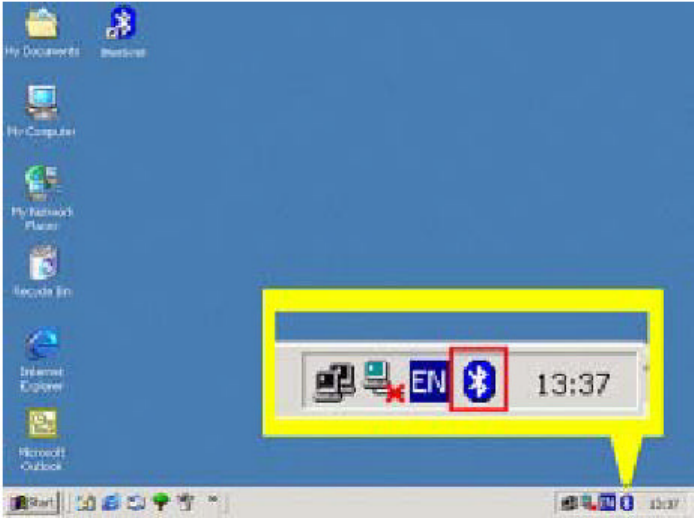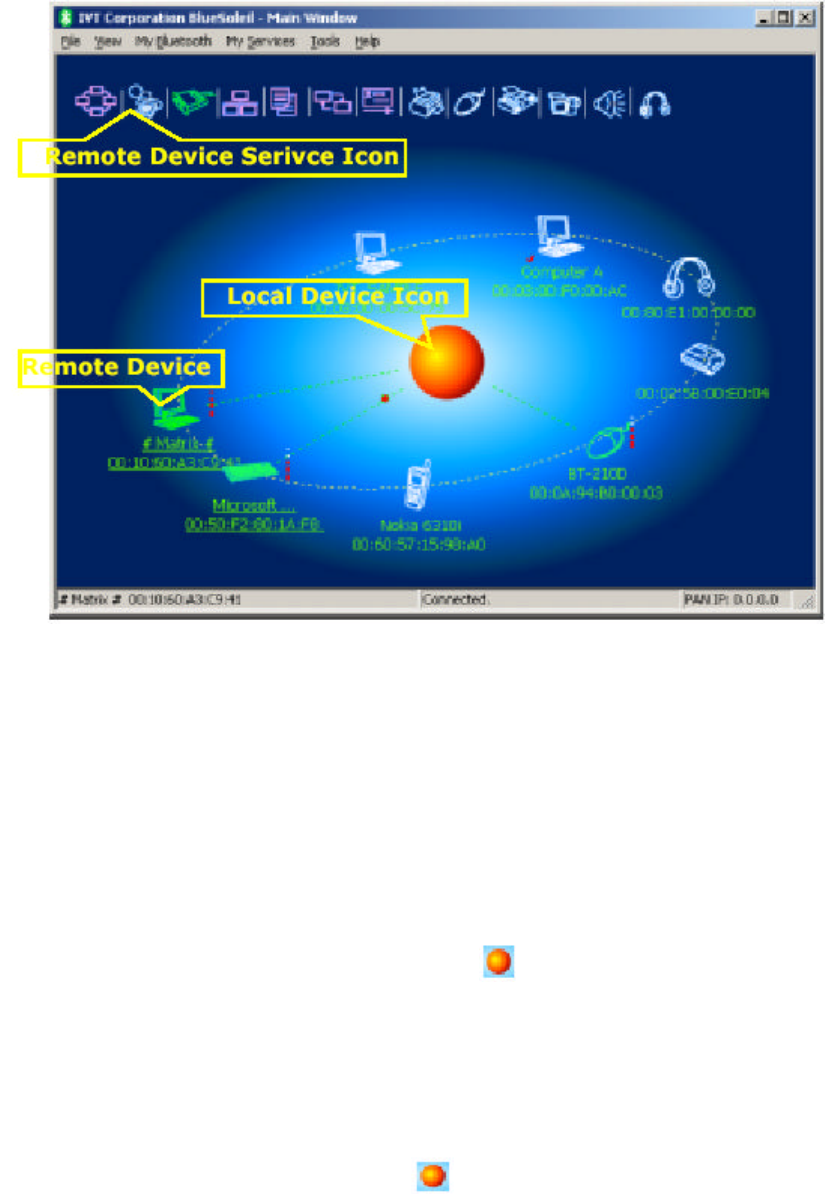GlobalSat WorldCom BTA-804A Bluetooth Dongle User Manual Implemented Bluetooth Profiles
GlobalSat WorldCom Corporation Bluetooth Dongle Implemented Bluetooth Profiles
Users Manual

1 BlueSoleil™ Introduction
BlueSoleil™ is a Windows-based Bluetooth Wireless software suite from IVT
Corporation. It is fully compliant to the latest Bluetooth SIG specifications.
BlueSoleil™ incorporates Bluetooth and computer technologies to enable users to
wirelessly access computing devices, form networks, and exchange information.
Implemented Bluetooth Profiles
* Personal Area Networking Profile
* Serial Port Profile
* Dial Up Networking Profile
* LAN Access Profile
* File Transfer Profile
* Human Interface Device Profile
* Headset Profile
* Hardcopy Cable Replacement Profile
* Object Push Profile
* Synchronization Profile
* FAX Profile
* Advanced Audio Distribution Profile
* Basic Imaging Profile
Host Requirement
* OS: Windows 98SE,ME,2000,XP
* CPU: 200MHz or above
* RAM: 32M or above
* Screen: 800*600 or above
* Display: Adapter True Color 16bits or above
2 BlueSoleil™ Basic Operations
2.1 Start BlueSoleil™
After installing BlueSoleil™, there are two ways to start the program:
1. A BlueSoleil™ shortcut icon on the Windows desktop.
2. An IVT BlueSoleil™ program group entry in the Windows’ Start | Programs
menu.
Double-click the BlueSoleil™ shortcut icon on the desktop or click the BlueSoleil™
menu item on the Start | Programs | IVT BlueSoleil™ menu to start the
BlueSoleil™ software.
The BlueSoleil™ icon will be displayed at the bottom right corner of the
Windows desktop (Figure 2.1).

Figure 2.1: BlueSoleil™ icon
2.2 Exit BlueSoleil™
To exit BlueSoleil™, right-click the BlueSoleil™ icon at the bottom right corner of the
Windows task bar and select Exit on the pop-up menu.
Note: Selecting the Close button at the top right corner of the BlueSoleil™ window
only hides the BlueSoleil™ window.
2.3 BlueSoleil™ Main Window
The BlueSoleil™ Main Window displays all surrounding Bluetooth devices. From
the BlueSoleil™ Main Window users can search for surrounding Bluetooth devices
and can execute connect/ disconnect functions.

Figure 2.2: BlueSoleil™ Main Window
2.4 What You Need To Do Before Build A Connection
2.4.1 Inquiring Bluetooth Devices
Method 1: Enquire Device
To start to set up a Bluetooth connection, you have to find the remote device you
want to connect first. You can choose one of the following methods to find the
remote device.
You may double click My Bluetooth Device icon or from MY Bluetooth Menu
-> Bluetooth Device Inquiry to find other Bluetooth devices in range. Bluetooth
devices within the radio range will be added to the orbit. The inquiry procedure will
search up to 7 devices each time. After it finds the devices or it has been 25 seconds
since the beginning of the inquiry, it will continue to refresh the names of the found
devices. Double clicking the local device or double clicking one of the remote
devices (to start to search profiles it supports) will stop the inquiry procedure.
Method 2: Add Device from History List
If there are more than 7 devices to find within the radio range, you can add the
device you have used to the orbit from the history device list. Click Tools Menu
and select Add Device from History. The History dialog box will be pop-up
Select the device from the list and click Add, the selected device will be added to
the end of the orbit. The shortcut key to open the History dialog box is Ctrl+H.
2.4.2 Pairing your desktop or laptop with a Bluetooth Device
Double click the remote Bluetooth device you want to connect and you will be asked
to enter the Bluetooth Passkey. Please type the Bluetooth Passkey in the Passkey
field .
Meanwhile, there will be a Bluetooth Passkey dialog box prompted on the remote
laptop or desktop equipped with the Bluetooth device to ask you to enter passkey.
The Bluetooth passkey should be the same between paired devices. If the pairing
process succeeds, there will be a red check on the paired Bluetooth device icon.
2.5 Start Or Stop A Bluetooth Service Connection
2.5.1 Search Bluetooth Service
You can double click the associated Bluetooth device icon or right-click on the icon
and select Refresh Services to find the service it provides. After service searching
finishes, the services the remote device supports and the corresponding service
icons on the top of the main window will change to be pink color.
2.5.2 Start A Remote Bluetooth Service Connection
You may right-click on the connected Bluetooth device, select Connect and
highlight the service you want to use .
Double click the pink profile icon (the service icon) you want to connect on the top
of the Main Window.
Connection will be setup. After connection is OK, the remote device and the service
icon will turn green.
2.5.3 Stop A Bluetooth Service Connection
There are two ways to stop the service:
. Select a started service and right click the service. On the popup menu, select
Stop Service. The service icon turns white. The service is stopped.
. Select a started service. Select My Services menu and highlight Stop Service.
The service icon turns white. The service is stopped.
Federal Communication Commission Interference Statement
This equipment has been tested and found to comply with the limits for a Class B digital
device, pur-suant to Part 15 of the FCC Rules. These limits are designed to provide
reasonable protection against harmful interference in a residential installation. This equipment
generates, uses and can radiated ra-dio frequency energy and, if not installed and used in
accordance with the instructions, may cause harmful interference to radio communications.
However, there is no guarantee that interference will not occur in a particular installation. If
this equipment does cause harmful interference to radio or television reception, which can be
determined by turning the equipment off and on, the user is en-couraged to try to correct the
interference by one of the following measures:
Reorient or relocate the receiving antenna.
Increase the separation between the equipment and receiver.
Connect the equipment into an outlet on a circuit different from that to which the receiver is
connected.
Consult the dealer or an experienced radio/TV technician for help.
FCC Caution: To assure continued compliance, (example – use only shielded interface
cables when connecting to computer or peripheral devices). Any changes or modifications not
expressly approved by the party responsible for compliance could void the user’s authority to
operate this equipment.
This transmitter must not be co-located or operating in conjunction with any other antenna or
trans-mitter.
FCC Radiation Exposure Statement
This equipment complies with FCC radiation exposure limits set forth for an uncontrolled
environ-ment. This equipment should be installed and operated with minimum distance 20 cm
between the ra-diator & your body.
This device complies with Part 15 of the FCC Rules. Operation is subject to the following two
condi-tions: (1) This device may not cause harmful interference, and (2) this device must
accept any inter-ference received, including interference that may cause undesired operation.
i